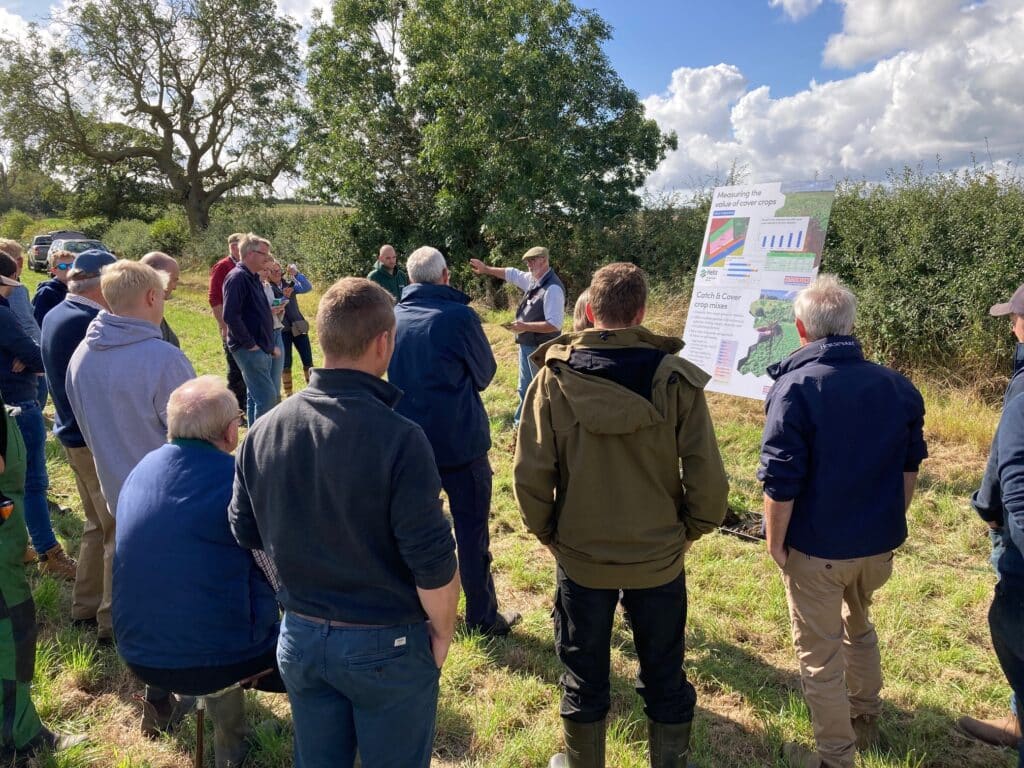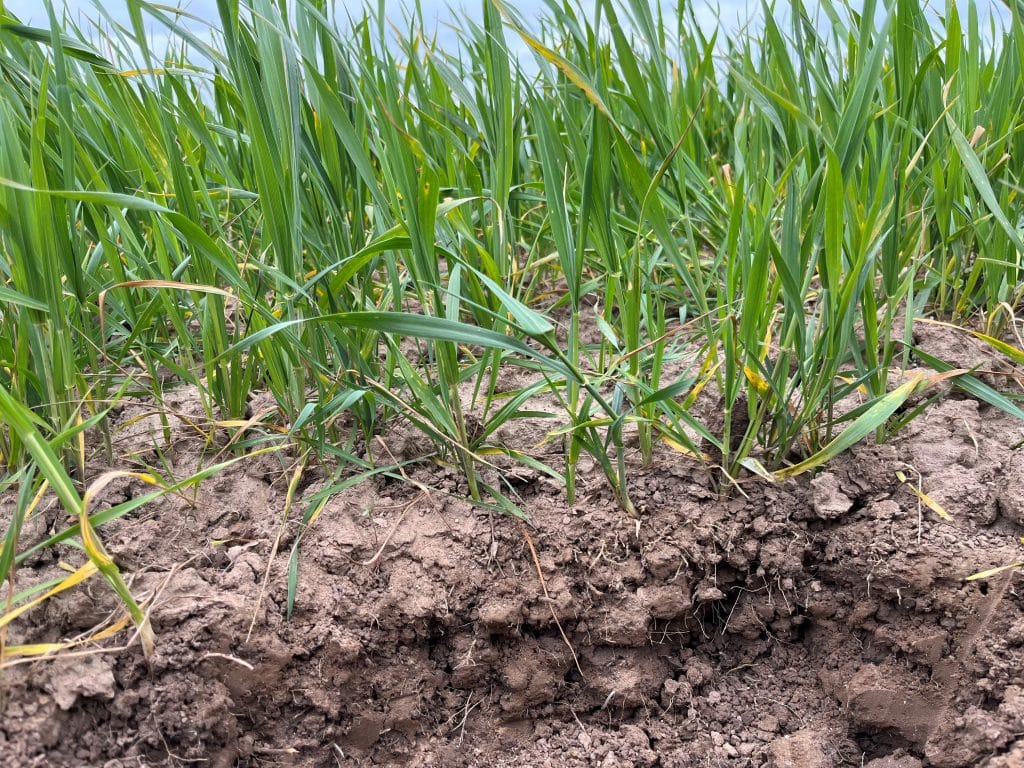System benefits the focus of SFI open day – Agronomist & Arable Farmer
Challenging soils at the recent Hutchinsons 'Right option, right place' open day made for an interesting discussion ...
Challenging soils at the recent Hutchinsons ‘Right option, right place’ open day made for an interesting discussion on how to make the Sustainable Farming Incentive work for the farm system and the environment.
With environmental schemes no longer just made up of field edges, and numerous Sustainable Farming Incentive (SFI) options. Selecting the most appropriate action isn’t easy.
Hutchinsons have been using fields at PF England and Son, Cambridge, to refine SFI strategies or, as Georgina Wallis, Hutchinsons head of environmental services, put it: “Learn from our mistakes.”
A key take-home message was that grow- ers shouldn’t see the soil pillars of physics, biology and chemistry in isolation – they are linked and influence each other.
First on the tour was cover crops. When looking at mix options, Alice Cannon, Hutchinsons regional technical support man- ager, said diversity is key, and suggested growers should pick up to eight species for winter cover crops. “Ideally, you want six to come through – with four the minimum.”
System gains
The mix has to be dictated by the system gains. Chasing a payment might not offer the greater benefit of improving soil structure or reducing the weed burden.
The knowledge gained has allowed Hutchinsons to offer some practical help for growers. With straight species plots, Alice was able to pinpoint some pros and cons.
One of those learnings is that despite a strong taproot, radish isn’t a subsoiler. Cover crops complement other strategies. Another significant one is straight cereals, which can be a management nightmare when going back into a cash crop, suggested Alice.
There’s also a potential yield penalty. “Being so high in carbon, the cereal cover crop absorbs all the soil nitrogen. Spring crop yields are determined early, so if soil nitrogen is in short supply, it can limit crop potential.” Phacelia will set seed and grow through the year, a management headache when used as a spring or summer cover option. But this is minor compared to its rooting benefits.
Alice noted the soils at the site are challenging, but it had done a good job in the heavy
ground. “Where the phacelia roots have been, the soil is nice and friable, and it also benefits beneficials. It’s great for pollinators – it ticks all the boxes.”
Diversity in the rotation
It is also a herb and, considering the importance of diversity, it is something many growers don’t have in their rotation, she added.
Camelina is another go-to species with similar properties to spring linseed, and it is interchangeable. “Its cobweb rooting structure ensures it will get into the smallest cracks, opening up soils, even high-magnesium soils like these. For lighter soils it holds it together.”
Even in a later-drilled period, camelina or linseed will work. “In such situations, these species will put their energy into rooting over growth. What is happening in the ground has the greatest effect on soil health.”
Alice was quizzed on linseed as a companion crop for cereals. She suggested peas or beans would be a better option, as it isn’t as robust against some herbicide chemistry.
She understands why mustard gets a mixed reaction. It has a strong root system and its flowers are good for bees, but it doesn’t tick the diversity box with rape in the rotation. It’s also another crop with a potential yield penalty. “It can take a lot of nitrogen out of the soil, impairing spring crop potential.”
When it comes to buckwheat, Alice admitted her views have changed. After struggling with it, she now sees it as a fantastic cover crop option. “It’s not a long-standing overwinter option as it doesn’t like frosts, and it needs to be drilled by mid-August. However, it grows quickly and has a fine, fibrous root, so it is excellent for soil structure and phosphorus scavenging. It also offers good weed suppression and benefits pollinators.”
Alice was again quizzed on companion crop use. She doesn’t consider it the complete answer to cabbage stem flea beetle in OSR, but pointed out those soil and nutrient benefits help create a healthier plant, better able to withstand pest pressures.
Nitrogen-fixing vetch
Vetch is a winter-hardy species and will pro- vide longevity for a cover crop mix. Its nitrogen-fixing properties are well known.
The question of a winter wheat companion was raised again. Alice’s advice is to stick with peas or beans. “It can be a management headache due to its cleaver-like growth habit, and it is more vulnerable to pre-em herbicides.”
Hutchinsons services specialist Jade Prince highlighted several benefits of the TerraMap Gold soil service, and how it allows for a more prescriptive use of cover crops. Key among these is a more detailed soil analysis beyond the standard index, to give precise data on the nutrients available to crops and the total in soil reserves. This means growers can address how to cycle those nutrients rather than apply more.
It also calculates the rate of organic matter cycling through, measuring active carbon, which allows growers to understand more about the value of soil organic matter.
The insight means growers can be more prescriptive with cover crop choices to manage specific problems better. “If the system detects phosphates in soil reserves but they are not available, growers should consider a species such as buckwheat, a known phosphate scavenger. Equally, if the carbon-to-nitrogen ratio is high, a legume-based mix may be more preferential than where the ratio is lower.”
In response to questions on compaction, Jade agreed with Alice that cover crops are not always a replacement for cultivation, and growers should take remedial action if need- ed. “Where a cover crop comes in is rebuilding that soil structure after disturbance. Using cover crops to enhance soil biology and chemistry to improve soil structure also help roots to penetrate further, drawing nutrients and moisture from a wider area,” she said.
At the soil zone, Hutchinsons demonstrated its trials with gypsum. This proved very effective in compacted situations. The Terramap Gold service revealed the calcium-magnesium ratio was low, and insufficient calcium meant magnesium was locking soils tight.
The gypsum, alongside cover crops, had corrected this imbalance, improving soil structure. “Where the gypsum has been applied, the upper surface is more friable. As the gypsum works its way down, it will improve the soil at greater depth. But there is no silver bullet, so complementary actions are also needed.”
“In just one year, an understory mix based around clovers and legumes, in conjunction with gypsum, had worked wonders. No cultivator will do this”
Making problems worse
The possibility of exacerbating problems was something that Hutchinsons technical manager Dick Neale focused on. The site has had nothing but cover crops, which does create its own unique problems, but it also has highlighted some of the issues growers could face when putting land back into mainstream cropping.
“There is no doubt that legume fallows and herbal leys are effective. Many growers have opted for a one-year legume fallow to replace OSR. In just one year, an understory mix based around clovers and legumes, in conjunction with gypsum, had worked wonders. No cultivator will do this,” he noted
However, where legume fallows are to be kept in the ground for longer, the work had revealed potential problems. Hutchinsons are seeing the aftermath of the old AB15 action at the site. After a two-year legume fallow was extended to three, soils had started to slump. Dick stressed that legumes are great at building nitrogen in the soil to feed biology around the root system. But once a high-legume mix gets past two years and the ground is destined for a cash crop, soils might need some remedial action.
“After destruction, the legumes have released all the nitrogen into the soil. That nitrogen has fed the biology as the microbiology consumed the carbon, so the aggregates have collapsed. It is not unsolvable, but something growers need to be aware of, as there is potentially a cost to moving that soil with a subsoiler, and possibly making direct drilling impossible.”
Oxtongue infestation
After being destroyed, the plot was redrilled with another legume fallow mix. Although drilled with grass, plots were dominated with bristly oxtongue. It is a culmination of growing repeated cover crops, but an indicator of the potential weed risk.
Dick sees legume fallows as restrictive and he suggested a herbal ley might be a better option for arable growers. “With legume fallows, growers are locked into no herbicides and a couple of mowings per season. The problem is that the seed return isn’t being controlled.”
He also mentioned groundsel. “It appear to be slipping through everything we do and there is no control option with a legume fallow. A bit of a problem can become a big problem as it can germinate, flower and pro- duce seed four times in a 12-month period.”

